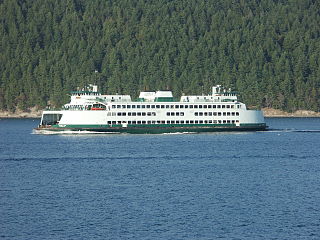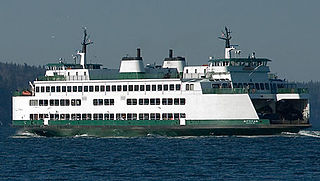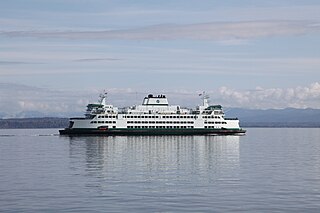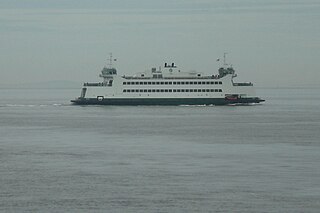
Washington State Ferries (WSF) is a government agency that operates automobile and passenger ferry service in the U.S. state of Washington as part of the Washington State Department of Transportation. It runs ten routes serving 20 terminals located around Puget Sound and in the San Juan Islands, designated as part of the state highway system. The agency maintains the largest fleet of ferries in the United States at 23 vessels, carrying 24.2 million passengers in 2016. As of 2016, it was the largest ferry operator in the United States, and the second-largest vehicular ferry system in the world.

The MV Cathlamet is an Issaquah 130 class ferry operated by Washington State Ferries.

The MV Sealth is the sole remaining Issaquah 100 Class ferry operated by Washington State Ferries.

The MV Hiyu was a ferry boat operated by Washington State Ferries. Originally built in 1967 to replace an earlier ferry, it was used on the Point Defiance–Tahlequah route during its early years. Upon its retirement in 2016, it was the smallest ferry in the fleet, with a capacity of 34 cars and 200 passengers, and a length of 162 feet (49 m).

The MV Chelan is an Issaquah-class ferry operated by Washington State Ferries, completed and in service in 1981. In 2004, the vessel was refit with a second vehicle deck, and in 2005 was refit with safety equipment to meet the requrements of the International Convention for the Safety of Life at Sea (SOLAS), allowing the Chelan to make international trips on the Anacortes–San Juan Islands–Sidney, BC route. As of April 2020 the Chelan is the only vessel in the Washington State Ferries fleet that meets SOLAS standards.

MV Kitsap is an Issaquah 130 Class ferry operated by Washington State Ferries. The Kitsap was built in 1980 as an Issaquah class and upgraded in 1992 moving it to the Issaquah 130 class due to adding an upper car deck. The vessel also received interior upgrades. The vessel used to have a rainbow color of blue, but has since been renovated with interior colors light, and dark blue, and dark green.

The MV Kittitas is an Issaquah 130 class ferry operated by Washington State Ferries.

The MV Tillikum is the sole remaining Evergreen State-class ferry operated by Washington State Ferries and one of the oldest ferries operating in the WSF system.

The Steel Electric-class ferries became part of the Washington State Ferry System when Puget Sound Navigation Company was acquired in 1951. They were built on San Francisco Bay for service on Southern Pacific and Northwestern Pacific Railroad routes across that bay.

Kwa-di Tabil-class ferries, were built for Washington State Ferries to replace the retired Steel Electric-class ferries. The vessels serve lower traffic routes and carry up to 64 vehicles. The State of Washington spent approximately $213 million to construct the three ferries in this class.

The Olympic-class ferries are the newest vessels to the Washington State Ferries fleet. They are intended to allow the agency to retire the aging Evergreen State-class ferries currently in service. The ferry design is based on the Issaquah-class ferries which have proven to be the most reliable and versatile in the fleet. The Olympic-class ferries are designed to serve all routes and terminals in the Washington State Ferries system. All vessels were built in Washington as required by state law since July 2001.

The Edmonds–Kingston ferry is a ferry route across Puget Sound between Edmonds and Kingston, Washington. Since 1951 the only ferries employed on the route have belonged to the Washington state ferry system, currently the largest ferry system in the United States. The last regularly operated steam ferry on the West Coast of the United States made its final run on this route in 1969.

The MV Baragoola is a ferry formerly operated by the Port Jackson & Manly Steamship Company and its successors on the Manly service. The sixth and final of the Binngarra type Manly ferries, the vessel entered service in 1922. Since its decommissioning as a ferry in 1983, the vessel has since been had a number of owners who have attempted to find a new role and restore it. Since 2003, it has been laid up at Balls Head Bay on the north side of Sydney Harbour as attempts to restore the vessel have continued.

The Seattle–Bainbridge ferry is a ferry route across Puget Sound between Seattle and Bainbridge Island, Washington. The route was called the Seattle–Winslow ferry before the city of Winslow annexed the rest of the island and changed its name. Since 1951 the only ferries employed on the route have belonged to the Washington state ferry system, currently the largest ferry system in the United States.

MV Salish is a Kwa-di Tabil-class ferry built at Todd Pacific Shipyards in Seattle, Washington for the Washington State Ferries. The vessel was put into service on July 1, 2011 on the Port Townsend-Coupeville route.
The MV Willapa was a car ferry that served on the San Francisco Bay and later on Puget Sound. She was one of the Steel Electric-class ferries built in 1927 for service across the San Francisco Bay. Originally named MV Fresno, she was operated by the Southern Pacific Railroad and provided ferry service across the bay.

The MV Chimacum is the third vessel of the Olympic-class auto ferries for the Washington State Ferries system. The ship was built by Vigor Industrial at their shipyard in Seattle, Washington and entered service on the Seattle–Bremerton route in 2017.

The MV North Head was a ferry operated by the Port Jackson & Manly Steamship Company and its successors on the Manly service from 1913 until 1985.

Bellubera was a ferry operated by the Port Jackson & Manly Steamship Company on the Manly service. Launched in 1910, she was the third of six "Binngarra-type" vessels. Upon her 1936 conversion from steam power, she became the first diesel-electric vessel in Australia. She was decommissioned in 1973, and scuttled at sea in 1980.

The E-Flexer is a class of Chinese-built Ro-Pax ferries ordered by Stena RoRo for European line service. Twelve vessels of the class are on order, and upon delivery will be operated by Stena Line, Brittany Ferries, DFDS Seaways and Marine Atlantic. Stena Line are to take five vessels of the class, Brittany Ferries five, and a single vessel each to DFDS and Marine Atlantic, of which the latter's vessel will also be hybrid electric. All of the vessels will be delivered to Stena RoRo with the Stena Line vessels transferred to that company and the Brittany Ferries, DFDS and Marine Atlantic examples long-term chartered to those operators, with an option to purchase at the end of the charter.



















